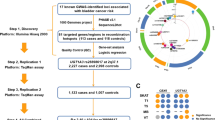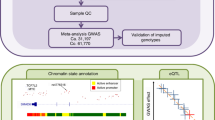Abstract
We conducted a genome-wide SNP association study on 1,803 urinary bladder cancer (UBC) cases and 34,336 controls from Iceland and The Netherlands and follow up studies in seven additional case-control groups (2,165 cases and 3,800 controls). The strongest association was observed with allele T of rs9642880 on chromosome 8q24, 30 kb upstream of MYC (allele-specific odds ratio (OR) = 1.22; P = 9.34 × 10−12). Approximately 20% of individuals of European ancestry are homozygous for rs9642880[T], and their estimated risk of developing UBC is 1.49 times that of noncarriers. No association was observed between UBC and the four 8q24 variants previously associated with prostate, colorectal and breast cancers, nor did rs9642880 associate with any of these three cancers. A weaker signal, but nonetheless of genome-wide significance, was captured by rs710521[A] located near TP63 on chromosome 3q28 (allele-specific OR = 1.19; P = 1. 15 × 10−7).
This is a preview of subscription content, access via your institution
Access options
Subscribe to this journal
Receive 12 print issues and online access
$209.00 per year
only $17.42 per issue
Buy this article
- Purchase on Springer Link
- Instant access to full article PDF
Prices may be subject to local taxes which are calculated during checkout

Similar content being viewed by others
References
Division of Cancer Control and Population Sciences, National Cancer Institute. Surveillance, Epidemiology, and End Results Program 1975–2004. <http://seer.cancer.gov/csr/1975_2004/results_merged/sect_27_urinary_bladder.pdf> (2007).
Aben, K.K. et al. Familial aggregation of urothelial cell carcinoma. Int. J. Cancer 98, 274–278 (2002).
Amundadottir, L.T. et al. Cancer as a complex phenotype: pattern of cancer distribution within and beyond the nuclear family. PLoS Med. 1, e65 (2004).
Murta-Nascimento, C. et al. Risk of bladder cancer associated with family history of cancer: do low-penetrance polymorphisms account for the increase in risk? Cancer Epidemiol. Biomarkers Prev. 16, 1595–1600 (2007).
Aben, K.K. et al. Segregation analysis of urothelial cell carcinoma. Eur. J. Cancer 42, 1428–1433 (2006).
Gudmundsson, J. et al. Genome-wide association study identifies a second prostate cancer susceptibility variant at 8q24. Nat. Genet. 39, 631–637 (2007).
Gudmundsson, J. et al. Two variants on chromosome 17 confer prostate cancer risk, and the one in TCF2 protects against type 2 diabetes. Nat. Genet. 39, 977–983 (2007).
Stacey, S.N. et al. Common variants on chromosomes 2q35 and 16q12 confer susceptibility to estrogen receptor-positive breast cancer. Nat. Genet. 39, 865–869 (2007).
Easton, D.F. et al. Genome-wide association study identifies novel breast cancer susceptibility loci. Nature 447, 1087–1093 (2007).
Tomlinson, I. et al. A genome-wide association scan of tag SNPs identifies a susceptibility variant for colorectal cancer at 8q24.21. Nat. Genet. 39, 984–988 (2007).
DePinho, R.A., Schreiber-Agus, N. & Alt, F.W. Myc family oncogenes in the development of normal and neoplastic cells. Adv. Cancer Res. 57, 1–46 (1991).
Mhawech-Fauceglia, P., Cheney, R.T. & Schwaller, J. Genetic alterations in urothelial bladder carcinoma: an updated review. Cancer 106, 1205–1216 (2006).
Gombert, W.M. et al. The c-myc insulator element and matrix attachment regions define the c-myc chromosomal domain. Mol. Cell. Biol. 23, 9338–9348 (2003).
Hallikas, O. et al. Genome-wide prediction of mammalian enhancers based on analysis of transcription-factor binding affinity. Cell 124, 47–59 (2006).
Emilsson, V. et al. Genetics of gene expression and its effect on disease. Nature 452, 423–428 (2008).
Urist, M.J. et al. Loss of p63 expression is associated with tumor progression in bladder cancer. Am. J. Pathol. 161, 1199–1206 (2002).
Koga, F. et al. Impaired p63 expression associates with poor prognosis and uroplakin III expression in invasive urothelial carcinoma of the bladder. Clin. Cancer Res. 9, 5501–5507 (2003).
Amundadottir, L.T. et al. A common variant associated with prostate cancer in European and African populations. Nat. Genet. 38, 652–658 (2006).
Yeager, M. et al. Genome-wide association study of prostate cancer identifies a second risk locus at 8q24. Nat. Genet. 39, 645–649 (2007).
Saccone, S.F. et al. Cholinergic nicotinic receptor genes implicated in a nicotine dependence association study targeting 348 candidate genes with 3713 SNPs. Hum. Mol. Genet. 16, 36–49 (2007).
Thorgeirsson, T.E. et al. A variant associated with nicotine dependence, lung cancer and peripheral arterial disease. Nature 452, 638–642 (2008).
Amos, C.I. et al. Genome-wide association scan of tag SNPs identifies a susceptibility locus for lung cancer at 15q25.1. Nat. Genet. 40, 616–622 (2008).
Hung, R.J. et al. A susceptibility locus for lung cancer maps to nicotinic acetylcholine receptor subunit genes on 15q25. Nature 452, 633–637 (2008).
Gretarsdottir, S. et al. The gene encoding phosphodiesterase 4D confers risk of ischemic stroke. Nat. Genet. 35, 131–138 (2003).
Falk, C.T. & Rubinstein, P. Haplotype relative risks: an easy reliable way to construct a proper control sample for risk calculations. Ann. Hum. Genet. 51, 227–233 s(1987).
Mantel, N. & Haenszel, W. Statistical aspects of the analysis of data from retrospective studies of disease. J. Natl. Cancer Inst. 22, 719–748 (1959).
Devlin, B. & Roeder, K. Genomic control for association studies. Biometrics 55, 997–1004 (1999).
Schadt, E.E. et al. Genetics of gene expression surveyed in maize, mouse and man. Nature 422, 297–302 (2003).
Stefansson, H. et al. A common inversion under selection in Europeans. Nat. Genet. 37, 129–137 (2005).
Epstein, J.I., Amin, M.B., Reuter, V.R. & Mostofi, F.K. The World Health Organization/International Society of Urological Pathology consensus classification of urothelial (transitional cell) neoplasms of the urinary bladder. Bladder Consensus Conference Committee. Am. J. Surg. Pathol. 22, 1435–1448 (1998).
Acknowledgements
We thank the individuals that participated in the study and whose contribution made this work possible. We also thank the nurses at Noatun (deCODE's participant recruitment center) and the personnel at the deCODE core facilities. We acknowledge the Icelandic Cancer Registry for assistance in the ascertainment of the Icelandic UBC cases. Collection of samples and data in Iceland and The Netherlands was funded in part by the European Commission (POLYGENE: LSHC-CT-2005-018827 and GENADDICT: LSHM-CT-2004-005166), the National Institute of Health (R01-DA017932) and a research investment grant of the Radboud University Nijmegen Medical Centre. The Leeds Bladder Cancer Study was funded by Cancer Research UK and Yorkshire Cancer Research. Torino Bladder Cancer Case Control Study was supported by a grant to ECNIS (Environmental Cancer Risk, Nutrition and Individual Susceptibility), a network of excellence operating within the European Union 6th Framework Program, Priority 5: “Food Quality and Safety” (Contract No 513943); by a grant of the compagnia di San Paolo, the Italian Association for Cancer Research, Italy and the Piedmont Region Progetti di Ricerca Sanitaria Finalizzata.
Author information
Authors and Affiliations
Corresponding authors
Ethics declarations
Competing interests
The authors from deCODE Genetics are shareholders in deCODE Genetics Inc. and therefore declare competing financial interests.
Supplementary information
Supplementary Text and Figures
Supplementary Methods, Supplementary Figures 1 and 2, Supplementary Tables 1–3 (PDF 391 kb)
Rights and permissions
About this article
Cite this article
Kiemeney, L., Thorlacius, S., Sulem, P. et al. Sequence variant on 8q24 confers susceptibility to urinary bladder cancer. Nat Genet 40, 1307–1312 (2008). https://doi.org/10.1038/ng.229
Received:
Accepted:
Published:
Issue Date:
DOI: https://doi.org/10.1038/ng.229
This article is cited by
-
The role of SOD2 and NOS2 genes in the molecular aspect of bladder cancer pathophysiology
Scientific Reports (2023)
-
Implementation of individualised polygenic risk score analysis: a test case of a family of four
BMC Medical Genomics (2022)
-
N6-methyladenosine-related single-nucleotide polymorphism analyses identify oncogene RNFT2 in bladder cancer
Cancer Cell International (2022)
-
Interaction between blood pressure and genetic risk score for bladder cancer, and risk of urothelial carcinoma in men
Scientific Reports (2022)
-
Development of a custom next-generation sequencing panel for the determination of bladder cancer risk in a Tunisian cohort
Molecular Biology Reports (2022)



